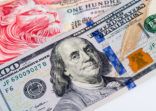When Trump’s tariff announcements triggered a sell-off in global financial markets, investors were caught off guard by an almost 50 basis point jump in long-dated 30-year US treasury yields.
Although there was some concern that this marked a shift in foreign demand for US government bonds, the move was more likely driven by a sudden unwinding of levered positions by certain trading firms.
This is according to strategists at State Street Global Advisors who pointed to the fact that long-dated US treasury rates rose more than swap rates or futures rates during the volatility.
“This may indicate that investors were selling cash bonds and receiving swaps or covering short futures positions in order to unwind these trades,” they said.
This drawdown in US treasuries “is not something new to the market” the strategists added, drawing comparison to similar moves during the Covid-19 sell off of March 2020 and the repo crisis of September 2019.
“When looking at these episodes, and taking an even longer-term view of historical data, we find that real money demand persists and usually comes back gradually after a spike in yield,” they said.
“This is because higher bond yields can attract especially price-sensitive investors by providing diversification, capital preservation and income.”
Two potential tailwinds for US treasuries
Looking ahead, the strategists see two potential tailwinds for the stability of long-dated treasuries: changes to the Fed’s supplementary leverage ratio (SLR) calculations and the privatization of Fannie Mae and Freddie Mac.
The SLR currently requires the largest US banks to hold capital equal to at least 5% of their assets, regardless of those assets’ risk weightings, essentially limiting how much US treasuries major US banks can buy.
The strategists argued that the exclusion of US treasuries from the Fed’s SLR calculations could encourage banks to increase their treasury securities holdings by roughly $1trn or more.
They pointed to the fact that in past periods when treasuries were temporarily excluded from the SLR (such as during the Covid-19 panic in 2020), treasury market liquidity “materially improved”.
Another reform they pointed to that could encourage more flows to US treasuries is the acceleration of the privatisation of Fannie Mae and Freddie Mac, which were acquired by the US government in 2008 in response to the global financial crisis.
“If privatisation were to be pushed forward this time around, proceeds could be used to pay down federal debt,” the strategists said.
“Privatisation could also prompt the Federal Reserve to increase the speed at which it is running down its agency mortgage-backed securities (MBS) holdings, in favor of treasuries (part of quantitative tightening, or QT).”
“Converting these agency MBS holdings to US treasuries would potentially lead to downward pressure on Treasury yields.”
Between the two potential tailwinds, the strategists said the SLR rule amendment would be “the easiest and most effective way” to restore stability to the US treasury market and cap yields.
They also said that further curve steepening could also help boost international demand for US bonds, both corporate and government.
Since the recent sell off was mostly in the longer-dated US treasuries, the spread between short-dated and long-dated bond yields has widened.
“This bear steepening is actually a positive factor when it comes to international demand for US bonds,” the strategists said. “International investors hedge their FX exposure using the front end of the curve, in exchange for locking in longer-term yields.”
The potential for the continuation of a mild steepening trend combined with another possible hike from the Bank of Japan could translate into lower hedge costs for Japanese investors, the strategists argued.
They said: “In general, ‘lower hedge costs plus a higher pickup in back-end spreads’ is a formula that could lead to increased international demand for US bonds—especially in corporate bonds, which offer a spread pickup over treasury rates.”

















